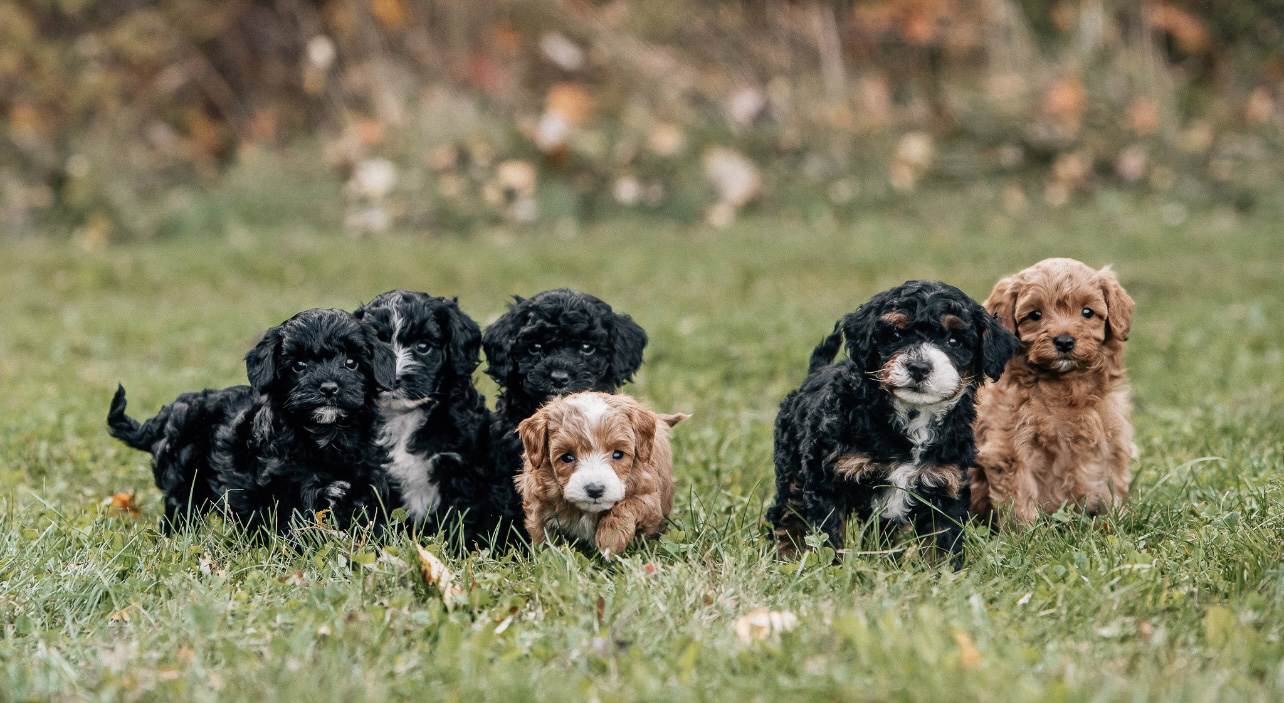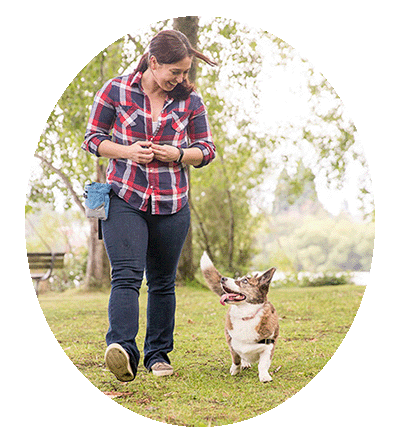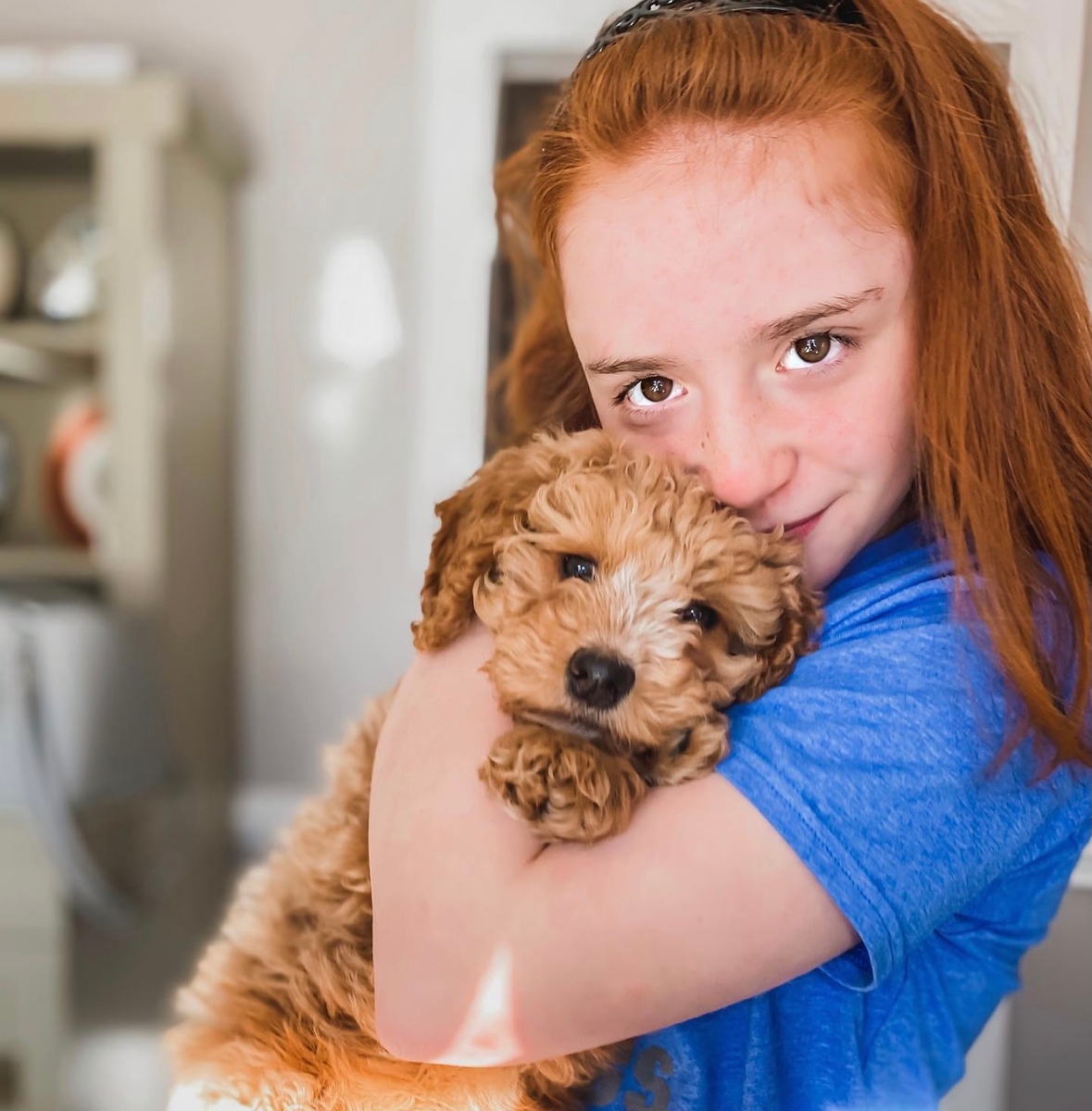Read Time: 10 minutes
Table of Contents
- Crate Training Quick Start: Your Puppy’s First 48 Hours
- How to Set Up a Puppy Crate for Training Success
- How to Choose the Right Puppy Crate Size
- Crate Training Timeline: What to Expect
- Puppy Crate Training Problems: Troubleshooting Guide
- Crate Training Reality: What to Actually Expect
- Puppy Crate Training FAQs: Common Questions Answered
- The Maple Hill Difference
Crate Training Quick Start: Your Puppy’s First 48 Hours
Crate training takes some work, but because we’ve already started the foundation at Maple Hill Doodles, you’re not starting from scratch.
Day 1 Priorities:
Set up the crate in your bedroom with cozy bedding, that mama-scented blanket, and a Snuggle Puppy (it has a heat pack and heartbeat that mimics their littermates).
First Night Expectations:
The first night will likely involve some adjustment. Your puppy is in a new place and missing their littermates. Take them out for a final potty break before bed, make sure the Snuggle Puppy is in the crate, and expect some vocalization – this is normal as they adjust.
When they cry, figure out if it’s a real need (like needing to potty) or just adjusting to the new environment. Respond to real needs, but stay consistent through the adjustment whining.
Your puppy has already learned crate basics with us, but adjusting to your specific home takes a few days. Be patient and consistent, and they’ll settle in.

How to Set Up a Puppy Crate for Training Success
Here’s the truth: crate training can be challenging, particularly in the beginning when you’re both adjusting. It’s one of those things that sounds simple in theory but feels overwhelming when you’re in the thick of it at 2 AM with a crying puppy. If you’re feeling anxious or uncertain about this, you’re not alone – that feeling is exactly what thousands of puppy parents before you have felt, and they all made it through. You will too!
The preparation you do before your puppy arrives makes all the difference. Think of it like setting up a nursery before a baby comes home – you wouldn’t buy a crib on delivery day, right? And just like preparing for a baby, it’s normal to feel a mix of excitement and “am I really ready for this?” Don’t worry – you’ve got this.
Understanding the Maple Hill Foundation
Here’s some good news that should make you feel a little better! Every puppy who leaves our home has already had positive crate experiences. We introduce crates at 4 weeks old as part of our Early Neurological Stimulation (ENS) program, so your puppy has learned that crates are safe, comfortable places where good things happen. The foundation is already built!
But here’s the thing I need you to understand – and this is where a lot of puppy parents get discouraged, so I want to prepare you. Even though your puppy did great in the crate here with us, they’re babies in a completely new environment at your home. Everything smells different, looks different, sounds different, and they’re away from their mama and littermates for the first time ever. Some regression is completely normal and expected! It’s not your fault, it’s not their fault – it’s just what happens when a baby transitions to a new home.
Your job isn’t to start from scratch – it’s to continue the positive training we began, with lots of patience for the adjustment period. And when I say patience, I mean the kind of patience you’ll need at 3 AM when you’re exhausted and your puppy is crying and you’re wondering if this will ever get easier. (It will, I promise!)
The Right Mindset Makes All the Difference
Before we get into the how-to, let’s talk mindset. Crate training works best when you approach it with realistic goals and genuine patience. Some days will be easier than others, and that’s completely normal.
Thoughts that help (repeat these when you’re struggling):
“I’m teaching my puppy a valuable life skill that will protect them forever.”
“Setbacks are part of the process, not signs of failure.”
“Small victories count – even tiny progress matters!”
“My puppy’s comfort comes first, even when it’s hard for me.”
“This is temporary. Every hard night brings us closer to success.”
Thoughts that hurt (but we all have them anyway):
“My puppy should love this immediately.” (Nope, that’s not realistic!)
“All this crying means I’m failing.” (It doesn’t – it means your puppy is adjusting!)
“This should be easy – the breeder started it.” (Starting and finishing are two different things!)
“I need perfection in three days.” (Even dog trainers don’t achieve this!)
Here’s what I want you to remember when you’re having one of those really hard moments: we’re aiming for acceptance and comfort, not necessarily passionate crate love. Some dogs grow to adore their crates and choose them for naps throughout their lives. Others simply tolerate them calmly when needed. Both outcomes are perfectly fine! The goal is a dog who doesn’t panic when crated, because there will be times in their life when being in a crate isn’t optional – and teaching them this skill now, even when it’s hard, is one of the most loving things you can do.
What to Realistically Expect
Every puppy learns at their own pace. Some families report their puppy adapted immediately – sleeping through the first night and entering the crate willingly from day one. Others need several days or a couple weeks to fully adjust. Both experiences are completely normal.
Your CavaDoodle, mini Goldendoodle, or Cavapoo will progress at their own pace. Stay consistent with the approach, celebrate small progress, and don’t worry about timelines.
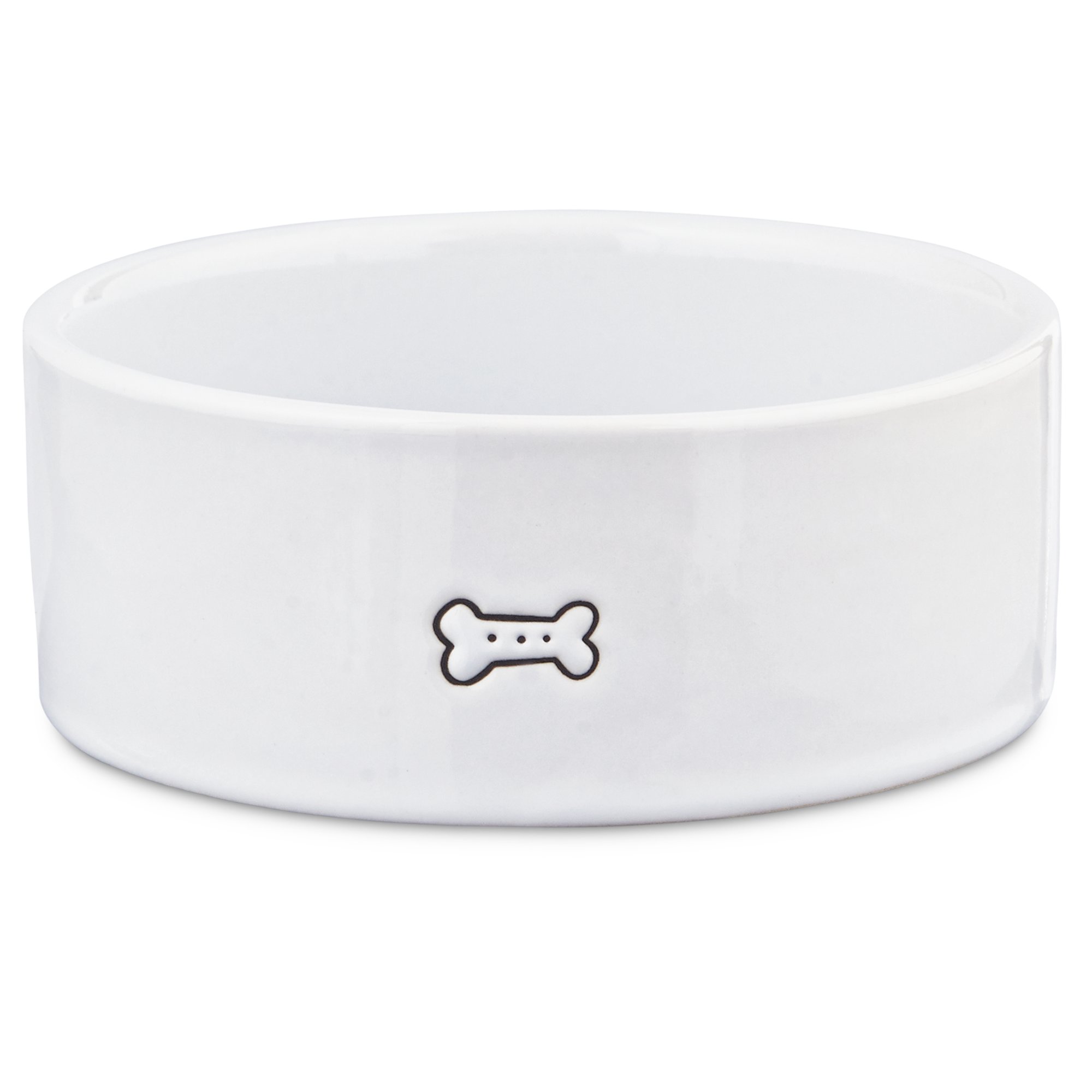
How to Choose the Right Puppy Crate Size
I know you’re probably overwhelmed with all the options out there, so let me simplify this for you. Not all crates are created equal, but the good news is you don’t need to overthink it – just follow these guidelines and you’ll be fine.
Wire vs. Plastic Crates: Which Crate is Best for Puppy Training?
Wire Crates:
Wire crates fold down to a compact size for easy storage. They are usually less expensive. You can easily see what your puppy is doing since the bars provide clear visibility. Plus, they’re super easy to clean (and trust me, you’ll be cleaning it!), and you can cover them with a blanket to create that cozy “den” feel.
Plastic/Hard-Sided Crates:
Plastic crates are more cozy and den-like, which some puppies prefer. They tend to be a bit more expensive and require a little more effort to take apart for storage. They’re easier to move around the house and offer less visibility. Some puppies who are completely overwhelmed by their new environment actually do better with these because there’s less visual stimulation.
Both types work well – choose based on your puppy’s personality and your household needs!
How to Measure Your Puppy for the Perfect Crate Fit
This is super important, and it’s one of those things that can make or break your success. Too big, and your puppy might use one corner as a bathroom (which defeats the whole purpose!). Too small, and they can’t be comfortable, which makes them hate the crate.
The perfect fit means your puppy can stand up without hunching, turn around completely, and lie down with their legs extended, with about 2-4 inches of clearance above their head when standing. That’s it! Not a mansion, not a closet – just right.
Size Guidelines for Maple Hill Doodles:
Nearly every puppy will need a 12 by 18 inch crate if they leave by 8 weeks. Our older Started Puppies will typically be in a 18 by 24 inch crate. Check our puppy supplies list for specific product recommendations.
Where to Place a Puppy Crate in Your Home
Where to Put the Crate:
For young puppies in those first 4-8 weeks, keep the crate in your bedroom at night (close to your bed) and in a family room during the day where activity happens. I know some people worry about creating bad habits, but trust me on this – your bedroom is where it needs to be for now.
Why your bedroom? Your puppy can hear you breathing and knows they’re not alone, which is hugely comforting when everything else is scary and new. Plus, you can hear when they genuinely need a potty break at night versus just protesting. This prevents anxiety and helps them settle so much faster! I’ve had puppy parents tell me they were against this idea at first, but it made all the difference in getting through those first weeks.
As they mature, you can gradually move the crate to its permanent location. Keep it away from drafty windows or doors, not in direct sunlight (they can overheat, especially when stressed), away from heat vents, in a quieter corner rather than the main traffic path, but still where they can see or hear family activity. You want them to feel included but not overwhelmed!
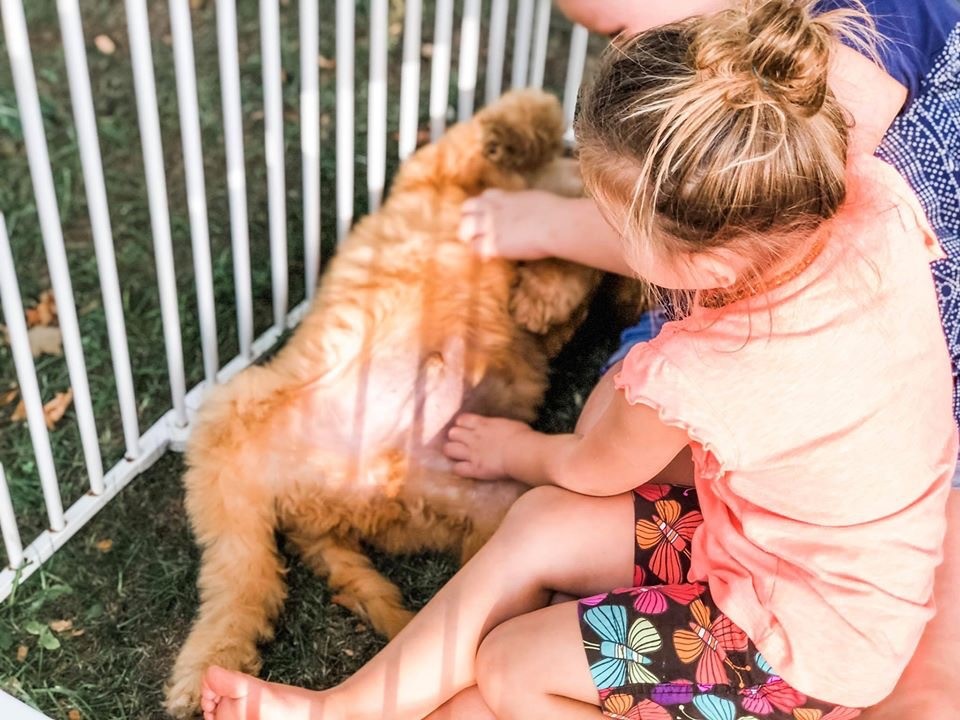
Crate Training Timeline: What to Expect
Here’s your realistic roadmap, and I want to emphasize “realistic” because I don’t want you comparing your progress to some idealized version you saw on TikTok. Every puppy is different, and this is a guide, not a strict rule!
Week 1: Foundation and Introduction – Your goal is simply getting puppy to enter the crate willingly for short periods (literally seconds to 5 minutes with you nearby). Success looks like your puppy walking into the crate for treats without fear. If this is all you accomplish in week one, you’re doing amazing!
Week 2: Building Confidence – Goal is puppy stays calm for 10-15 minutes alone, gradually extending to 30 minutes. Success means minimal whining and settling down to rest. You’ll probably still have some rough moments, but you should see improvement.
Weeks 3-4: Extending Time – Goal is being comfortable for 1-2 hours during the day, working toward age-appropriate limits. According to the American Veterinary Medical Association, puppies can typically hold their bladder one hour for each month of age, plus one. Success looks like puppy resting calmly – the crate is just normal life now. This is where you start to feel like a real person again! is being comfortable for 1-2 hours during the day, working toward age-appropriate limits. According to the American Kennel Club, puppies can typically hold their bladder one hour for each month of age, plus one. Success looks like puppy resting calmly – the crate is just normal life now. This is where you start to feel like a real person again!
Weeks 4-8: Nighttime Success – Goal is sleeping through the night with appropriate potty breaks for younger pups (6-8 hours overnight for older puppies). Success means peaceful nights and you’re actually getting real sleep! This is when you’ll start to feel like yourself again and actually enjoy your puppy.
Month 2-3: Solid Reliability – Goal is calm acceptance in various situations for age-appropriate periods. Success looks like the crate being just part of the routine, no big deal. You made it!
Remember, these are averages! Your Maple Hill puppy comes with a foundation, but the adjustment to your home varies for each individual. Be patient with them and yourself. On the hard days (and there will be hard days), remember why you’re doing this – you’re teaching your puppy a skill that will keep them safe and calm for their entire life.

Puppy Crate Training Problems: Troubleshooting Guide
Why Does My Puppy Cry in the Crate at Night?
Causes: Not ready for that duration, crate uncomfortable, needs potty, or learned crying gets them released.
Solutions:
- Go back to shorter durations (decrease by 50%)
- Rule out physical needs (potty, temperature)
- Wait for quiet (even 2 seconds counts)
- Tire them out before crating
- Give them a bully stick or marrow bone to keep occupied
Quick Fix: Set timer for 2 minutes. If quiet for 3 seconds, release and praise. If crying entire time, only release when quiet.
How to Stop Puppy from Peeing in Crate
Causes: Crate too large, crated too long, or medical issue.
Solutions:
- Adjust divider to make crate smaller
- Increase potty breaks (every 2-3 hours for 8-12 week olds, as recommended by veterinary experts at UC Davis School of Veterinary Medicine)
- Clean with enzyme cleaner (remove ALL scent)
- Get vet check (rule out UTI/parasites)
- Go back to shorter crating periods
Never punish accidents – just clean and adjust approach.
Puppy Crate Training Regression: What Happened to My Progress?
Causes: Growth spurts, something scared them, routine change, fear period (8-11 weeks, 6-14 months), or medical issue.
Solutions:
- Don’t panic – regression is normal
- Go back 2-3 steps in training
- Check for environmental triggers
- Schedule vet visit if sudden change
- Stay consistent – don’t abandon training
Fear periods are normal – be patient and supportive, they’ll pass.
Puppy Separation Anxiety in Crate: How to Help
Causes: Separation anxiety developing, learned your leaving routine, not enough alone practice.
Solutions:
- Mix up routine (crate randomly throughout day)
- Practice fake departures (get ready but don’t leave)
- Real departures starting at 30 seconds
- No big goodbyes (stay calm and boring)
- Encourage independent play when home
Gradual approach works best – build slowly so they never panic.

Crate Training Reality: What to Actually Expect
Let me give you the unfiltered truth – crate training is one of the hardest parts of bringing home a puppy.
The First Week Will Be Rough
Your puppy is in a new environment, away from everything familiar. Even though we’ve started crate training at Maple Hill Doodles, they need time to adjust.
You might experience: crying at night, accidents despite your best efforts, refusing to enter, sleep deprivation, second-guessing everything.
Remember: This is temporary, every puppy goes through this, it doesn’t mean you’re failing, your patience will pay off.
Progress Isn’t Linear
Some days will be great, others feel like square one. Common patterns: three steps forward, one back; good days followed by rough nights; perfect at home, panic at vet; sudden regression during fear periods.
Stay consistent and don’t give up during rough patches.
Every Puppy Is Different
Your neighbor’s puppy trained in a week? Your puppy might take two months. Neither is “better.” Factors affecting timeline: personality, previous experiences, your environment, your consistency, age and developmental stage.
Don’t compare – focus on your own progress.
The Goal Isn’t Perfection
Realistic success: enters without drama, settles within reasonable time, handles vet/groomer/travel without excessive stress, accepts crate as normal. That’s it! Loving the crate is a bonus, not required.
You Will Make Mistakes
Everyone does. You might let them out during crying (3 AM desperation!), push duration too fast, forget potty breaks. Acknowledge it, adjust, move forward, give yourself grace.
Your puppy won’t be damaged by training missteps. Just stay consistent going forward.
The Payoff Is Worth It
All these sleepless nights will be worth it when you have a dog who handles crating calmly at the vet, during travel, when you need them safe, throughout their life when crating is necessary.
You’re teaching skills that will serve them for 10+ years!

Puppy Crate Training FAQs: Common Questions Answered
Let’s tackle the most common questions I hear from new puppy parents, usually asked with a mixture of hope and desperation!
How Long Does Puppy Crate Training Take?
The honest answer? It varies – and I know that’s not what you want to hear when you’re exhausted! Most puppies show solid acceptance within 4-8 weeks, but I’ve seen it take anywhere from 2 weeks to 3 months depending on the individual puppy. The puppies from Maple Hill Doodles have a head start since we’ve already introduced crates, but they still need time to adjust to your specific home.
Think of it as a journey, not a destination with a finish line. Even after your puppy is “trained,” you’ll continue using the crate and reinforcing those positive associations throughout their life. The initial training phase is rough, but it does end – I promise!
My puppy cries in the crate. Am I doing something wrong?
First, take a breath – some crying at first is totally normal, and it doesn’t mean you’re failing! The trick is figuring out whether they’re crying because they need something (bathroom, thirst, genuine discomfort) or just protesting the situation because they’d rather be with you.
If they genuinely need something, respond immediately every time – let them out for a quick bathroom break, then calmly back in the crate. No shame in this! If it’s protest crying (and you’ll learn to tell the difference – it sounds more angry than desperate), wait for even a moment of quiet, then reward that silence with calm praise.
If you release them while they’re actively crying, you’re accidentally teaching them that crying equals freedom, and trust me, that’s a lesson that’s hard to undo! It’s hard to resist those puppy whimpers but consistency here really pays off!
Can a puppy sleep in a crate on the first night?
Quick Answer: Yes, puppies can sleep in a crate on the first night with proper setup and realistic expectations for adjustment.
Set up the crate in your bedroom with comfortable bedding, the mama-scented blanket we provide, and a Snuggle Puppy with heat pack and heartbeat. Expect some vocalization as your puppy adjusts to the new environment – this is normal. Take them out once or twice during the night for potty breaks (8-10 week old puppies can only hold their bladder 2-3 hours).
Some Maple Hill puppies sleep peacefully their first night because of our early crate training. Others need a few nights to fully adjust to their new home. Both are normal.
Can I ever use the crate for punishment?
NO! Never, ever, not even once, even when they’ve just chewed your favorite shoes or had an accident on your bed! This is honestly the fastest way to ruin all the positive associations you’re building, and undoing that damage is way harder than whatever you’re dealing with in the moment.
Your puppy should think “Crate = cozy, safe, happy place where good things happen and I can relax!” NOT “Crate = where I go when I’m in trouble and mom/dad is mad at me!”
If you need to manage or correct behavior, use appropriate training techniques that have nothing to do with the crate. Time outs? Use a bathroom or laundry room. Need them out of your hair? Exercise them first, THEN crate them with a Kong. The crate must remain Switzerland – completely neutral or positive, always!
Should I Cover My Puppy’s Crate at Night?
Many puppies feel way more secure with the crate partially covered, creating that den-like feeling their instincts are looking for. I usually recommend covering three sides with a breathable blanket, leaving the front open so they don’t feel trapped.
Try it both ways and see what your specific puppy prefers – some love the cozy enclosed feeling and settle immediately, others prefer to see out and keep an eye on things. There’s no one right answer, and what works for one puppy might not work for another!
Just make sure whatever you use is breathable and secure – you don’t want them pulling it through the bars and creating a suffocation hazard or an expensive mess! Also, make sure there’s still airflow – a completely covered crate can get stuffy and uncomfortable!
When Can I Stop Using the Crate? Transitioning from Crate to Freedom
This is totally up to you and depends on your individual dog! Some people continue using crates throughout their dog’s entire life for management, safety, and because their dog genuinely loves it as their special spot. Others gradually give more house freedom once their dog is mature, trustworthy, and has earned it.
Signs your dog might be ready for more freedom:
Consistently reliable with house training – we’re talking months of zero accidents, not just a good week! No destructive chewing behavior – they’ve outgrown the “everything is a toy” phase! Staying calm when left alone – no separation anxiety or stress! Mature – usually 12+ months old at minimum, sometimes older for certain breeds!
Even if you give full house freedom eventually, please keep the crate available and set up! You’ll still need it for vet visits, grooming, travel, emergencies, and unexpected situations. Plus, many dogs continue to use their crate as a cozy nap spot even when they don’t have to – it’s their special place!
The Maple Hill Difference
At Maple Hill Doodles, located in beautiful Northeast Ohio just a short drive from Cleveland, we don’t just breed adorable puppies (though they really are pretty darn cute, if I do say so myself!). We set up both you and your new family member for a lifetime of success, and crate training is a huge part of that foundation.
What Makes Our Approach Special
We begin crate introduction at 4 weeks old, way before your puppy comes home. I know this might not seem like a big deal, but this early foundation makes a massive difference – it’s the difference between starting from scratch and building on a solid base!
Our crate training approach aligns with recommendations from the American Veterinary Medical Association and veterinary experts at UC Davis School of Veterinary Medicine, combining research-backed methods with our 25 years of hands-on experience placing hundreds of puppies in loving homes.
Keep Learning and Growing Together
Crate training is just the beginning of your amazing journey together! Continue building your puppy knowledge with these resources we’ve created specifically for families like yours:
Related Articles:
Why Crate Train Your Puppy – Understanding the benefits and importance, and why it’s worth the effort!
3 Challenges Puppy Parents Face – Common struggles and how to overcome them!
Leaving Your Dog Home Alone – Tips for building independence and preventing separation anxiety!
Finding the Best Breeder – What to look for when choosing a responsible breeder (or to understand what makes us different!)
Early Neurological Stimulation (ENS) Program – See exactly how we prepare your puppy from day one!
Getting Prepared:
Puppy Supplies List – Everything you need before bringing your puppy home!

